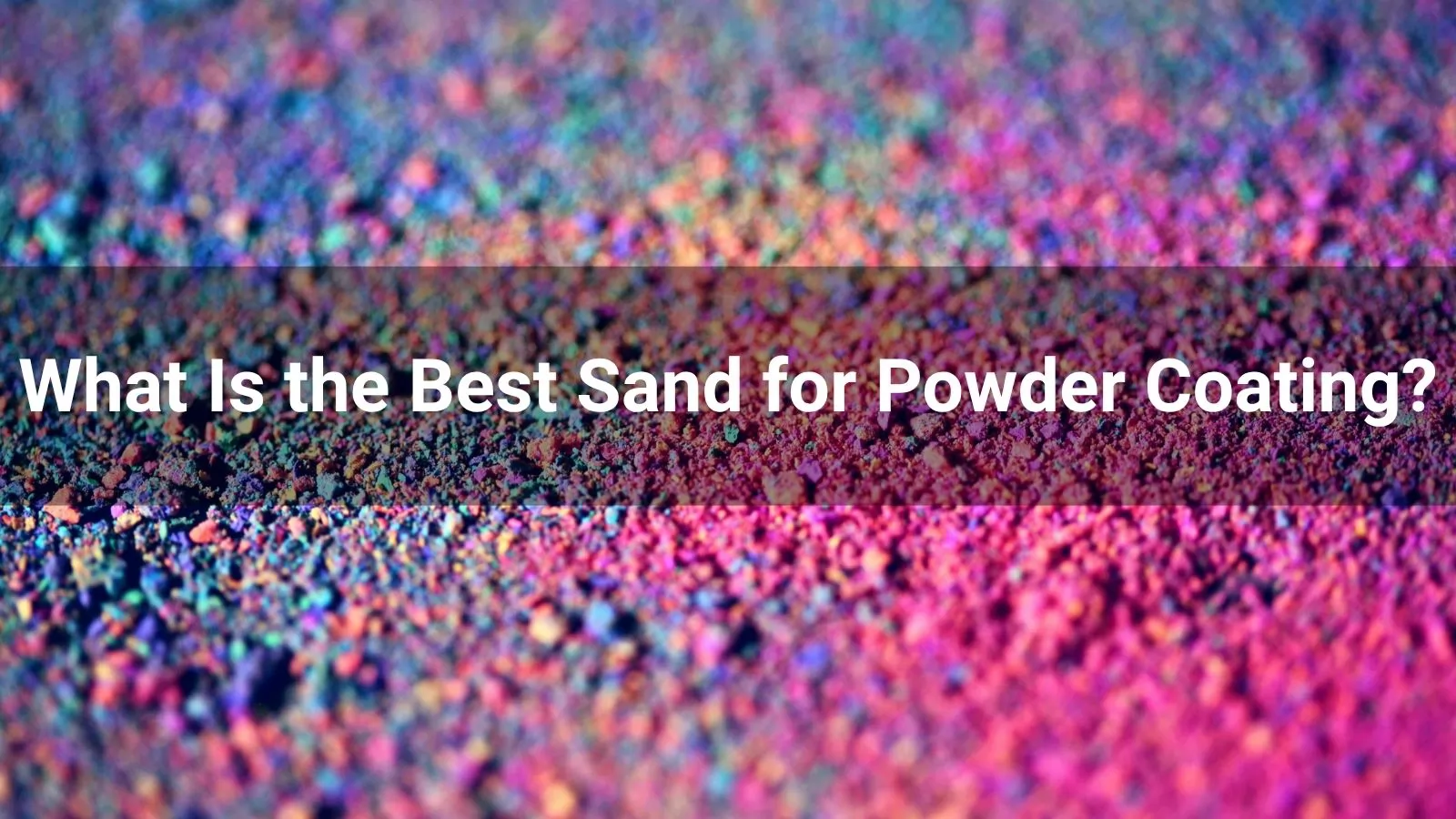
.png)
.png)


-
.png) 0086-757-85407388
0086-757-85407388 -

-
 terrychen@wintoly.com
terrychen@wintoly.com


.png)
.png)


.png)




Powder coating is a robust and environmentally friendly method for applying protective and decorative finishes, primarily to metal surfaces. A key preparatory step in this process is abrasive blasting, which involves using sand or similar media to clean and texture the substrate, ensuring strong adhesion of the coating. Selecting the appropriate abrasive media is critical to achieving a flawless, long-lasting powder-coated finish. This article delves into the best types of sand and alternative abrasives for powder coating, exploring their properties and key considerations for choosing the most suitable option.
Abrasive blasting is essential because it removes contaminants like rust, old paint, grease, and oxidation, leaving a clean, slightly textured surface that promotes excellent coating adhesion. The choice of abrasive directly influences the surface finish, preparation efficiency, and overall quality of the powder coating. An unsuitable abrasive can result in poor adhesion, uneven coating application, or even damage to the substrate, compromising the final result.
Selecting the right abrasive for powder coating requires careful consideration of several factors. The hardness of the abrasive must be sufficient to remove contaminants without damaging the substrate. Particle size plays a significant role, as finer particles produce smoother finishes, while coarser ones create a rougher texture for better coating grip. The shape of the abrasive—whether angular for aggressive cutting or rounded for gentler action—also matters, particularly for delicate surfaces. Cleanliness is crucial to prevent introducing contaminants like oil or dirt to the surface. Additionally, the reusability of the abrasive can impact cost-effectiveness, with some media offering multiple uses, while others are single-use but more affordable upfront. Finally, environmental impact is a growing concern, with eco-friendly options gaining preference to reduce waste and health risks.
While the term "sand" is commonly used, silica sand is largely avoided in modern powder coating due to its health risks and inconsistent performance. Instead, alternative abrasives have become the standard for their safety and effectiveness. Below are the most commonly used options, each with unique properties suited to specific applications.
Aluminum oxide is a hard, angular abrasive renowned for its excellent cutting ability. Available in grit sizes ranging from 36 to 120, it is a versatile choice for powder coating preparation. This abrasive creates a consistent, uniform surface profile that ensures strong coating adhesion across a wide range of substrates, including steel, aluminum, and stainless steel. Its durability allows for multiple reuses, making it cost-effective over time despite a higher initial cost. Aluminum oxide excels in heavy-duty tasks like rust and paint removal, making it ideal for tough metals, though its cost may be a consideration for budget-conscious projects.
Garnet, a natural abrasive with moderately hard, angular to sub-angular particles, is available in grit sizes from 30 to 120, with 80-100 grit being common for powder coating. It produces a smooth, consistent surface profile with low dust, making it an environmentally friendly and recyclable option. Garnet is well-suited for general-purpose blasting on metals like steel and aluminum, though it is less aggressive than aluminum oxide, which may increase preparation time for heavy rust or thick coatings. Its balance of performance and eco-friendliness makes it a popular choice for many applications.
Glass beads are spherical abrasives made from recycled glass, creating a smooth, polished surface ideal for delicate substrates. Available in sizes from 60 to 170 grit, they produce a finer, less aggressive profile, perfect for achieving a satin-like finish on materials like aluminum or stainless steel. Their low dust production and reusability add to their environmental appeal. However, glass beads are not suited for heavy rust or paint removal due to their gentle action, making them best for projects requiring a refined finish rather than aggressive cleaning.
Steel grit, a hard, angular abrasive made from crushed steel, is available in grit sizes from 40 to 80 for powder coating. It is highly effective for removing heavy rust, scale, and old coatings, creating a deep, angular surface profile that enhances coating adhesion. Its durability and recyclability make it a cost-effective choice for heavy-duty applications on steel or iron parts. However, its aggressive nature can damage softer metals like aluminum, requiring careful use to avoid surface harm.
Plastic abrasives, made from materials like urea or acrylic, are softer and less common but valuable for specific applications. These angular particles are gentle on delicate substrates, preventing warping or damage, and are ideal for soft metals, composites, or thin-walled parts. They produce minimal dust and are reusable, but their higher cost and limited effectiveness for heavy contaminant removal make them a niche choice for specialized projects.
Silica sand, once a staple in abrasive blasting, is no longer recommended for powder coating preparation. Inhaling silica dust poses significant health risks, including silicosis, a serious lung disease. Additionally, silica sand’s inconsistent particle size and shape lead to uneven surface profiles, compromising coating quality. Environmental concerns, such as hazardous waste disposal, further discourage its use. Regulatory bodies, like OSHA in the United States, enforce strict guidelines limiting silica sand in blasting, pushing safer alternatives like aluminum oxide and garnet to the forefront.
The ideal abrasive depends on the substrate, surface condition, and desired finish. Aluminum oxide is widely regarded as the top choice for most powder coating applications due to its versatility, ability to create a consistent anchor-patterned profile, and long-term cost-effectiveness through reusability. For delicate surfaces or smoother finishes, glass beads or garnet offer excellent alternatives, providing gentler action and refined results. Steel grit is a strong contender for heavy-duty steel parts but requires caution on softer materials to prevent damage.
To maximize the effectiveness of abrasive blasting, match the grit size to the task—coarser grits (36-60) for heavy rust or paint removal and finer grits (80-120) for smoother finishes. Controlling blasting pressure, typically between 60 and 100 PSI, ensures effective cleaning without substrate damage. After blasting, thoroughly clean the surface with compressed air or a solvent wipe to remove residual abrasive and dust, ensuring a pristine surface for coating. Investing in a quality blast cabinet or system helps control dust and recycle media, improving efficiency. Always prioritize safety by wearing appropriate personal protective equipment, such as respirators, to avoid inhaling dust.
Choosing the right abrasive for powder coating preparation is vital to achieving a durable, high-quality finish. Aluminum oxide stands out as the most versatile and effective option for a wide range of applications, while garnet, glass beads, steel grit, and plastic media provide specialized benefits tailored to specific substrates and project needs. By steering clear of silica sand and opting for safe, high-performance abrasives, you can ensure a clean, well-prepared surface that enhances the adhesion and longevity of your powder coating, delivering professional results every time.

 terrychen@wintoly.com
terrychen@wintoly.com
.png) 0086-757-85407388
0086-757-85407388
 6 Chaoyang Rd., National Demonstration Eco-industrialzone, Nanhai, Foshan,Guangdong,China
6 Chaoyang Rd., National Demonstration Eco-industrialzone, Nanhai, Foshan,Guangdong,China

.png)
